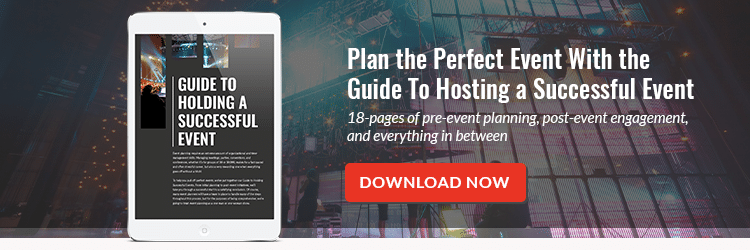Intimidating. Inauthentic. Uninspiring. Ah yes, the corporate event. While glad-hands may welcome this opportunity to network and meet the like-minded in the crowd, most others will casually slink out the door (or to their hotel room) once the presentation is through. So why is it that so many people hate corporate events? They’re boring. It’s no longer enough to put a speaker on a stage and hand them a mic to excite an audience, no matter how dynamic they may be. Today, holding an experiential event is necessary to capture attention (and maybe customers). So what is experiential event planning? Here are a few ideas that can make a big impact.
6 Ways to Make an Event Experiential
LED Display Walls
Humans rely on sight the most when it comes to just about everything, so your event content needs to take advantage of that! An LED wall can showcase your brand and event messaging by being bright, bold, and in your face (in a good way). Rather than straining to see a presentation, an LED display helps event attendees absorb content by providing it visually. LED walls can be shaped, curved, and scaled to match any event aesthetic, and fit any venue.
Lighting Design
Never underestimate the importance of lighting. The right lighting can draw in a crowd, creating a unique atmosphere that keeps attendees engaged while highlighting speakers. An eye-popping LED video wall can make a big, bright, and bold statement, while a gobo light (GOes Before Optics) can project words or a large corporate logo onto your backdrop. Want to get really experiential? Consider intelligent lighting. If you’ve ever seen a presenter fight with the spotlight, or chase it around the stage, intelligent lighting (also known as moving lights or moving heads) makes this a non-issue. Using automated or mechanical techniques that older stationary systems just can’t provide, intelligent lights can highlight presenters or products in a unique and eye-catching way. Rather than blind an audience with old-school lighting, spellbind them with intelligent lights.
3D Projection Mapping
You may have heard it referred to as video mapping or spatial augmented reality. Whatever you want to call it, 3D projection mapping is a cool way to engage at your event. Rather than project on a flat screen, this technology projects onto any three-dimensional surface, no matter how irregularly shaped it may be, and turns it into a display surface for video projection. These objects could be as complex as a building or a vehicle, or as simple as a stage prop or the stage itself. Even if the venue won’t allow you to project on the exterior of the building, using projection mapping in the areas outside the conference room can create unique digital signage that will drop jaws as guests drop in.
Instagram-Friendly Spots
It’s not a fad, but a lifestyle! Today, Instagram boasts over 1 billion active users around the globe and is the preferred social network of Millennials (born between 1980 and 1995) and Generation Z (born between 1995 and 2015) in the United States—even beating out social giants like Facebook and Twitter. Take a page from pop-up shops and create a dedicated Instagram space where attendees can snap photos and selfies. This can make your event a hot spot, and get your brand noticed on social media. Because Instagram is a very visual medium, photos should be high-quality, so be sure your dedicated space is well-lit, with colorful backdrops and props (you may even consider interactive props that allow Instagrammers to have some fun, like those mustaches-on-a-stick or feathery boas).
Virtual Reality & Augmented Reality
They’re no longer just the stuff of science-fiction. Virtual reality gives event attendees an experience they’ve never had before simply by donning an apparatus over the eyes. Have a unique product? Let your attendees “experience” it through VR. With prices on simple VR applications coming down, this is a great way to engage your audience. (Want more ideas? We love the VR inspiration from this site). Another great way to engage is through augmented reality. This technology transforms an attendee’s tablet or smartphone into an interactive experience in which their real-world environment is “augmented” by computer-generated information or imagery. Think of it as Pokémon Go—for the event goer! The technology can be incorporated into an event app, for example, to overlay graphic over areas of the venue and trigger experiences; it could also be used to overlay information over products during demos. The possibilities are endless when it comes to these exciting technologies.
Social Media Walls
Rather than have event attendees tuning out and texting their friends, get them interacting with the event itself. A social media wall, whether displayed on video screens or projected onto walls, is a great engagement tool that publishes social media and text communications related to the event in real-time on a leaderboard that also helps identify influencers (Everwall is a great example of a company specializing in this technology). Worried about guests getting inappropriate? Posts can be monitored and edited by a moderator with a simple posting delay in place. While each of these ideas works on an individual level to engage people, imagine the impact you could have on attendees if you were to incorporate all of these elements into one groundbreaking event! With proper planning and a bit of ingenuity, it’s possible, even if you have to execute some elements within a smaller space, such as a coffee break room or networking venue. If it works in the main room? More power to you! Either way, attendees will appreciate and remember your event when you take it to the next level by getting experiential. Need more ideas? The experts at One Way Event Productions can help.


